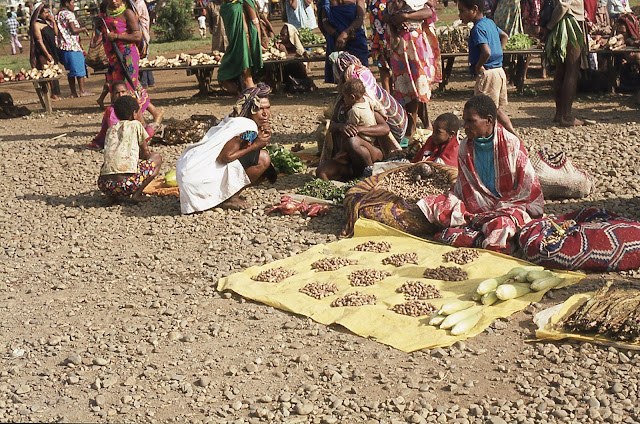In 1974, my wife Gail and I had the opportunity to work in Mt Hagen in the Western Highlands of Papua New Guinea. We travelled extensively throughout the Enga, Western, and Chimbu districts with the odd excursion into the Eastern Highlands, Lae and Madang. Over the next few weeks / months I will post blogs on many of the these trips. Written comments however will be rather fleeting as it will depend on what notes I made on slides at the time and dredging through my memory banks from over 43 years ago.
I took up a position at Mt Hagen High School as head of science and through school contacts was able to travel out into the bush to a number of tribal sing sings and to see village life as it had been for many hundreds of years.
 |
| http://www.geographicguide.com/oceania-maps/guinea.htm |
Mt Hagen was not discovered by Europeans until 1930 when Mick Leahy and Michael Dwyer were prospecting in the Ramu River and stumbled across the Goroka Valley which lead onto the Waghi Valley where Mt Hagen in located. Danny Leahy joined them later and built the first wooden house on the hill around 1933.
 |
| Danny Leahy's house, only reached on foot above Mt Hagen. |
 |
| The Mt Hagen Range from inside the fence at Danny Leahy's |
 |
| Mt Hagen town. |
 |
| Mt Hagen town. |
The town of Mt Hagen, (5,600ft asl.) is surrounded by mountain ranges on three sides averaging around 13,000 feet high. The height of these ranges provided and interesting plane trip when we finally left Mt Hagen back to Port Morseby. More about this later.
Roading in 1974 consisted of one way highway into the Highlands from Lae over some high passes (one was 9,100 feet). Very little tar-seal existed. There were a number of roads linking the Highlands together and we made good use of these in our brand new Datsun 120Y. Fortunately our 7 months in PNG coincided with the dry season. Most of the roads would only be accessible by 4WD when the rains come.
 |
| Shiny new 120Y, yet to get its number plates. |
The Highlands in 1974 was very much a subsistence farming society made up of many different tribal groups, some friendly towards each other and some at war. We were to see examples of tribal warfare and the culture of payback in operation during our stay there. More in later blogs.
Tea and coffee plantations provided a good source of income. Oh for some more Kurumul tea!
 |
| Village gardens plots. |
 |
| Raised beds of kau kau. |
The staple food in the Highlands is a sweet potato variety called kau kau. The raised beds provide drainage when it rains. Although downpours can dump as much as 100mm of rain in 20 minutes ( I got soaking wet one day when a 250 mL beaker was filled one afternoon), the water drains away rapidly in the rich volcanic soil. During the wet season the grounds would be water logged, hence the drainage channels.
Pigs play can important part in the culture of the local people. One's wealth its often measured in terms of the number of pigs you own. Pig meat is reserved for special occasions, such as weddings and sing sings and as compensation. (More about a compensation ceremony we went to later.)
 |
| Tethered wealth. |
 |
| The little piggy won't go to market. |
 |
| Waghi Valley haus and crop of sweet corn. |
I have not spelt the name of the dwelling incorrectly but used the word commonly used. One quickly learnt basic Pigeon English (Pisin) as Papua New Guinea is home to 700-800 languages and Pigeon developed quickly when Europeans arrived. The country was a German colony before the Australians took over in 1914 and so Pigeon is made up of lots of German terms and Australian vernacular although the ring of Pisin goes back more than hundred years. ( No guessing what the haus sik is.). There are loads of made up terms too - mix masta bilong jesus is a helicopter.
Every Saturday the most popular place in Mt Hagen was the village market. The women, meris would load their bilums, string carry alls which rested of their heads, with extra produce from their gardens and walk for hours to sell in the middle of town. There were lots of small pick up trucks around too.
 |
| Beans and kau kau for sale |
 |
| Peanuts and sweet corn for sale here. |
 |
| Proud Highland mere showing off her pikinini. |
The pikininis are carried in the mother's bilum. We had an interesting experience when we were out in a village one weekend and Gail was admiring someone's baby in its bilum. A sudden bowel motion was quickly dealt with by the use of a cabbage leaf from another bilum with a nearby pig quickly recycling the spoils. No waste, no mess, one way (eventually) of getting your own back?
Some photos in an earlier blog taken at various sing sings etc. near Mt Hagen here.
My next blog is about Mt Hagen High School.
Some photos in an earlier blog taken at various sing sings etc. near Mt Hagen here.
My next blog is about Mt Hagen High School.
Was there from 70 to 73. ! Amazing country. !
ReplyDelete